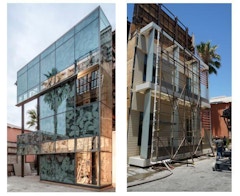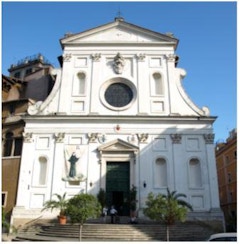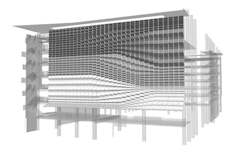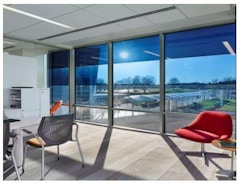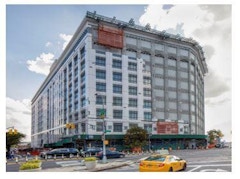
344 results
-
 The transformation of a dark and inhumane 1970s tilt-up concrete office building into a high performance, light-filled modern workplace was enabled…
The transformation of a dark and inhumane 1970s tilt-up concrete office building into a high performance, light-filled modern workplace was enabled… -
Transitions Between Diverse Envelope Systems
- Paper by Kristian Fosholt, LEED AP BD+C · Megan Koehler, AIA, LEED AP BD+C · Andrew Tsay Jacobs, AIA, EIT, LEED AP BD+C
The Lucile Packard Children’s Hospital at Stanford University in Palo Alto, California features an extremely diverse set of facade systems within one
-
Transformation as Movement
- Paper by Vytenis Gureckas
In 1888 the art historian Heinrich Wölfflin proposed the notion that the primary characteristic of baroque architecture is the illusion of movement.
-
Towards A Data Driven Fabrication Process
- Paper by Becher Neme · Michael Kilkelly
Today's evolving digital tools allow designers to be more creative in designing new forms and geometries. Adapting similar tools to the fabrication
-
Thinking About Facades
- Paper by Marc Schiler, FASES, LC
There have been three decades of liberating developments in the application of descriptive geometry and freeform design methods, as well as the
-
Thermal Comfort Assessment of Multi-Zone Electrochromic Window
- Paper by Ahoo Malekafzali, Ph.D.
Access to natural daylight and connection to the outdoor environment is one of the key elements of contemporary architecture. This design concept is
-

Thermal Analysis of Complex Glazing
- Paper by Adrian Turcato · Chris Stutzki · Erik Olsen
The use of bidirectional scattering distribution function incorporated in a transient systems simulation program, allows engineers to accurately
-
The Thermal Blanket Concept
- Paper by Bharat Patel, PE, CEM, LEED AP · Michael Bulander, AIA, LEED AP
This paper tells the story of a Double Skin Facade (DSF), where high performance and multi-disciplinary collaboration saves a library concept of
-
The Double Skin Facade
- Paper by Lee A. Fithian, AIA, AICP, NCARB, LEED AP
The largest source of air pollution in North America is the atmospheric boundary layer of a city caused by its urban canyons with pollutants produced
-
Terracotta 1912 to 2018
- Paper by Carol Loewenson, FAIA, LEED AP · Stephen Dietz, AIA, LEED AP
Center Three is a 100-year-old, one million square-foot building in Long Island City, New York that was constructed over the course of one year. It
-

Teaching Facades
- Paper by Alex Terzich
As facades become more sophisticated and complex, more detail-intensive and performance-critical, it's vital that architecture students develop a
-

Targeted Enclosure Consulting
- Paper by Karl Jones,
As building enclosure consulting services evolve and mature in markets, the scopes of service that are provided and sought, can become more… -
Subjective Perception and Objective Measurement
- Paper by Caroline Lama · Antonio Luz · Ashley Reed
Current glass industry standards provide clear tolerances for readily quantifiable physical properties to assist with the evaluation of visual
-
Structuring Skin
- Paper by John Neary
Curtain wall is the prevailing type of enclosure on modern buildings because of its economy, its independence from structure that allows flexibility
-

Specifying Commercial Aluminum Finishes
- Paper by Ben Mitchell, MBA,
Many factors will influence coating selection, but to achieve the desired performance level for a given situation, coatings must be specified based… -

Silicone Spandrel Glass Opacifiers
- Paper by Scott Norville, Samir Blanchet, George Torok, Kris Vockler, John Swanson, Chris Barry, Lawrence Carbary, Stephane Hoffman, Timothy Krytenberg, Chris Fronsoe,
Curtain wall design commonly uses insulating glass units for vision and spandrel glazing to provide better visual harmonization of building facade… -

Shadow Box Design
- Paper by Mark Walsh
Shadow boxes are commonly used in curtain wall construction, but can be problematic if not designed and detailed correctly and appropriately for the
-

Separating Direct From Diffuse
- Paper by Nick Novelli, PhD, Robert Gordon, Igor Varfolomeev,
An Enclosure-Integrated, Daylighting, Tracking Solar Collector (EIDTSC) has been developed for market which integrates into a building’s fenestration… -

Seismic Movements
- Paper by Gijs Libourel · Daniel Segraves
A common building upgrade to add value to existing commercial real estate is the renewal of the entrance lobby. The lobby facade is replaced to give
-
Retrofit Options for Historic Facades
- Paper by Carrie Davis, P.E., LEED Green Assoc. · George Kantrales, Ph.D. · Matt Barsotti · Andrew Schoenheit · Ty Vandergriff
Building design criteria requires that government buildings be designed for a variety of extreme loads including blast, hurricane, and impact
